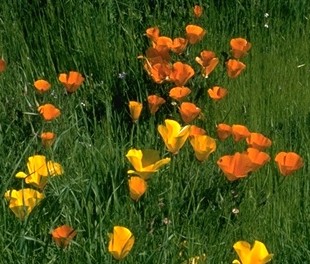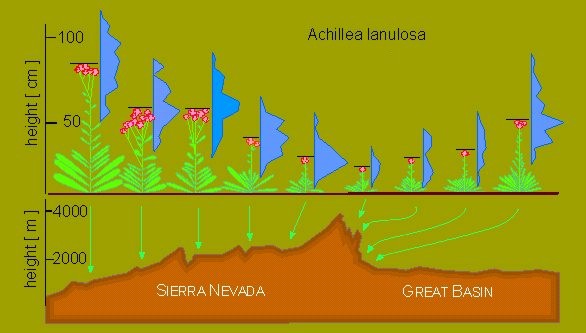 The California
poppy occurs along the coast of western North American from Washington State to Baja California.
Within this range, the California poppy experiences a wide range of environmental conditions and not
surprisingly ecotypic differentiation occurs. There are two general categories of ecotypes. In
populations occurring in moist environments, poppies grow long roots that reach groundwater, and
plants live longer than one year. Here, seeds germinate in the fall, and both
juveniles and adults overwinter as rosettes close to the ground. In populations occurring in arid
environments, poppies grow only shallow roots. Seeds germinate in the fall, producing a small
rosette. Plants grow, set seed and die within one year. The different ecotypes
produce geographic variation in several other morphological traits, including stamen number, flower
structure, and flower color (flowers vary from orange to all yellow with intermediate shading of
orange and yellow).
The California
poppy occurs along the coast of western North American from Washington State to Baja California.
Within this range, the California poppy experiences a wide range of environmental conditions and not
surprisingly ecotypic differentiation occurs. There are two general categories of ecotypes. In
populations occurring in moist environments, poppies grow long roots that reach groundwater, and
plants live longer than one year. Here, seeds germinate in the fall, and both
juveniles and adults overwinter as rosettes close to the ground. In populations occurring in arid
environments, poppies grow only shallow roots. Seeds germinate in the fall, producing a small
rosette. Plants grow, set seed and die within one year. The different ecotypes
produce geographic variation in several other morphological traits, including stamen number, flower
structure, and flower color (flowers vary from orange to all yellow with intermediate shading of
orange and yellow).It is possible that some of the observed variation in ecotypes results from the ability of individuals to respond differently to changes in environmental factors. All individuals have some range of response as the environment changes. For instance, plants from the same population usually grow taller in the longer growing season of low elevations than they do in the shorter growing season of high elevations. To separate the phenotypic and genotypic components of variation in ecotypes, it is necessary to grow representatives from each ecotype under the same conditions.
Clausen, Keck, and Hiesey (1948) studied the ecotypic races of Achillea lanulosa (yarrow) across the Sierra Nevada. With rising elevation, winter temperature drops below freezing, so that winter dormancy is necessary and plants are smaller. On the eastern slope of the mountains, individuals flower late and are adapted to the cold, arid climate. The researchers collected seeds from a series of these yarrow populations and raised them in a greenhouse at Stanford University.

Representatives of populations of Achillea lanulosa as grown in a uniform garden at Stanford. They originated in the different localities shown in the profile below of a transect across central California at approximately 38 degrees N latitude. Elevations are to the scale shown in meters. Horizontal distances are not to scale. The plants represent a population of approximately 60 individuals. The frequency diagrams show variation in height within each population. The specimens represent plants of average height, and the lines above each plant indicate the mean heights.
Since the major attributes of these races were maintained when grown under uniform conditions in the same place, it is clear that these adaptations had a genetic basis. That is, each of the races had diverged genetically from the others in response to the challenges of their local environments.
Evolution & Ecology 101 --Introduction to Ecology
Genetically Caused Variability within the Species Achillea lanulosa
Krebs, Charles J. 1978. Ecology The Experimental Analysis of Distribution and Abundance. Second Edition. Harper & Row, Publishers.
Clausen, J., D. D. Keck, and W. M. Hiesey. 1948. Experimental studies on the nature of species. III. Environmental responses of climatic races of Achillea. Carnegie Inst. Washington Pub. No. 581. 129 pp.